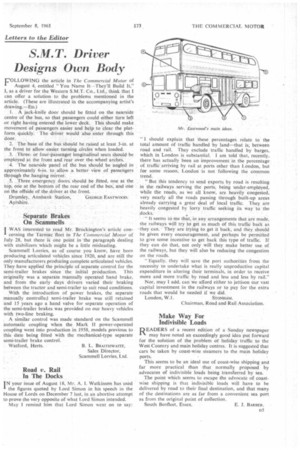Letters to the Editor
Page 69

If you've noticed an error in this article please click here to report it so we can fix it.
S.M.T. Driver Designs Own Body
FOLLOWING the article in The Commercial Motor of August 4, entitled "You Name It—They'll Build It," I, as a driver for the Western S.M.T. Co., Ltd., think that I can offer a solution to the problems mentioned in the article. (These are illustrated in the accompanying artist's drawing.—En.)
1. A jack-knife door should be fitted on the nearside centre of the bus, so that passengers could either turn left or right having entered the lower deck. This should make movement of passengers easier and help to clear the platform quickly. The driver would also enter through this door.
2. The base of the bus should he raised at least 3-in, at the front to allow easier turning circles when loaded.
3. Threeor four-passenger longitudinal seats Should be employed at the front and rear over tile. wheel arches.
4. The nearside panel of the bus should be angled in approximately 6-in, to allow a better view of passengers through the hanging mirror.
.5. Three emergency doors should be fitted, one at the top, one at the bottom of the rear end of thebus, and one on the offside of the driver at the front.
Drurnley, Annbank Station, GEORGE Essirw000. Ayrshire.
Separate Brakes On Scammells
-WAS interested to read Mr. Brockington's article con' cerning the Tarmac fleet in The Commercial Motor of July 28, but there is one point in 'the paragraph dealing with stabilizers which might be a little misleading.
Scammell Lorries, as of course you know, have been producing articulated vehicles since 1920, and are still the only manufacturers producing complete articulated vehicles. They have applied the principle of separate control for the semi-trailer brakes since the initial production. This originally was a separate manually operated hand brake, and from the early days drivers varied their braking between the tractor and semi-trailer to suit road conditions.
With the introduction of power brakes, the separate manually controlled semi-trailer brake was still retained and 15 years ago a hand valve for separate operation of the semi-trailer brakes was provided on our heavy vehicles with two-line braking.
A similar control was made standard on the Scammell automatic coupling when the Mark II power-operated coupling went into production in 1958, models previous to this date being fitted with the mechanical-type separate semi-trailer brake control.
Watford, Herts. B. L. BRAITHWAITE,
Sales Director.
Scammell Lorries, Ltd.
Road v. Rail In The Docks
IN your issue of August 18, Mr. A. I. Watkinson has used I the figures quoted by Lord Simon in his speech in the House of Lords on December 7 last, in an abortive attempt to prove the very opposite of what Lord Simon intended.
May I remind him that Lord Simon went on to say:
"I should explain that these percentages relate to the total amount of traffic handled by land—that is, between road and rail. They exclude traffic handled by barges, which in London is substantial. 1 am told that, recently, there has actually been an improvement in the percentage of traffic :arriving by rail at ports other than London, but for some reason. London is not following the common trend.
"But this tendency to send exports by road is resulting in the railways serving the ports, being under-employed, while the roads, as we all know, are heavily congested, very nearly all the roads passing through built-up areas already carrying a great deal of local traffic. They are -heavily congested by lorry traffic seeking its way to the docks.
" It seems to me that, in any arrangements that are made, the railways will try to get as much of this traffic back as they can. They are trying to get it back, and they should be given every encouragement, and perhaps be permitted to give some incentive to get back this type of traffic. If they can do that, not only will they make better use of the railways, but they will also be reducing the congestion on the roads.
Equally, they will save the port authorities from the necessity to undertake what is really unproductive capital expenditure in altering their terminals, in order to receive more and more traffic by road and less and less by rail."
Nor, may I add, can we afford either to jettison our vast capital investment in the railways or to pay for the extra roads that would be needed if we did.
London, W.1. STONI1/64.
Chairman, Road and Rail Association.
Make Way For Indivisible Loads
READERS of a recent edition of a Sunday newspaper
may have noted an exceedingly good idea put forward for the solution of the problem of holiday traffic to the West Country and main holiday centres. It is suggested that cars be taken by coast-wise steamers to the main holiday ports.
This seems to be an ideal use of coast-wise shipping and far more practical than that normally proposed by advocates of indivisible loads being transferred by sea.
The point which seems to escape the advocate of coastwise shipping is that indivisible loads will have to he delivered by road to their final destination, and that many of the destinations are as far from a convenient sea port as from the original point of collection.
South Benfleet, Essex.
E. J. BARBER.


































































































































































